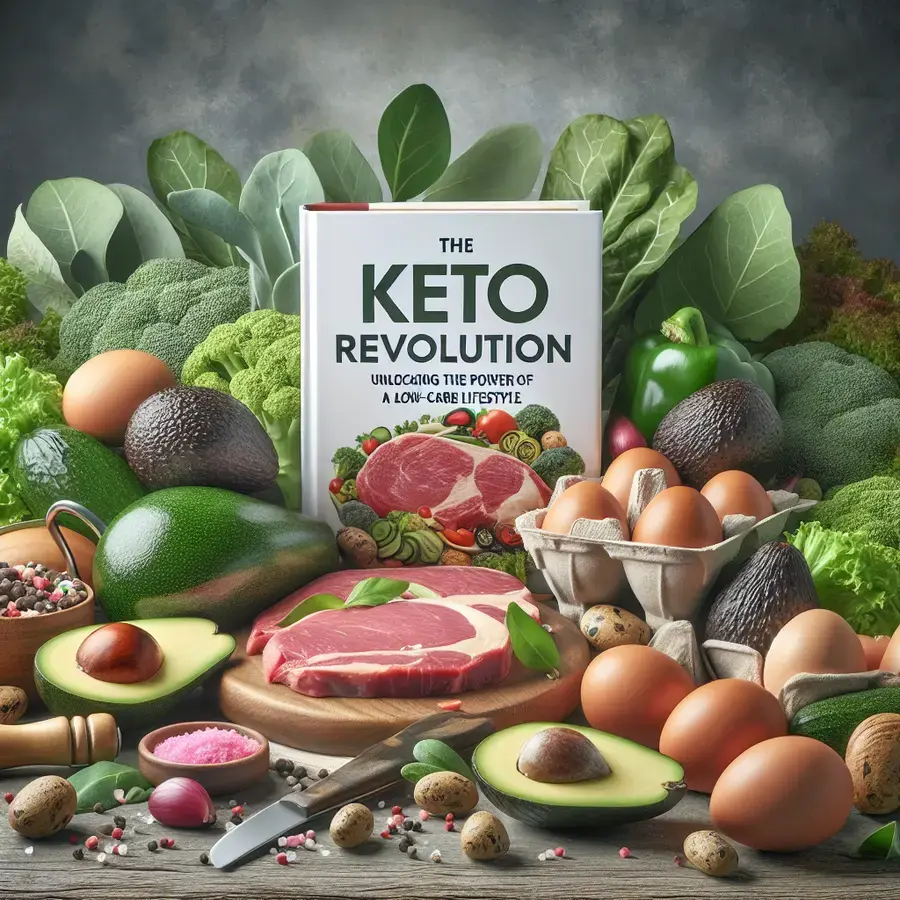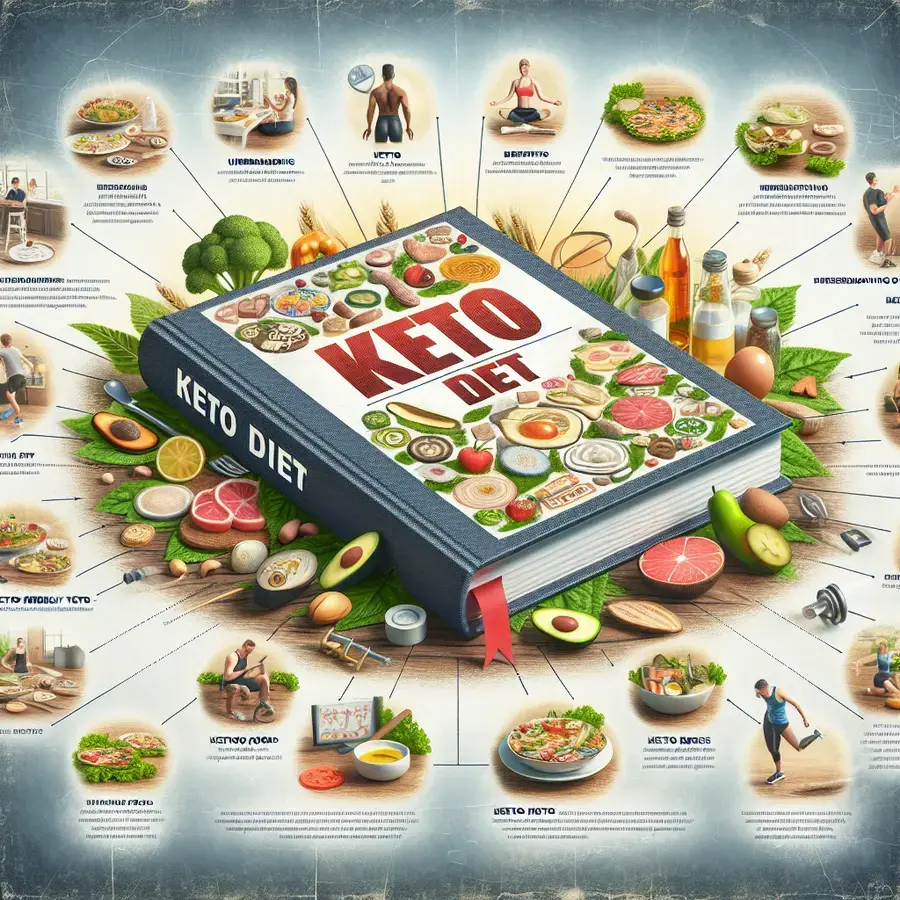The Keto Revolution: Unlocking the Power of a Low-Carb Lifestyle

The ketogenic diet, commonly referred to as the keto diet, has taken the world by storm, with millions of people adopting this low-carb, high-fat lifestyle to achieve significant weight loss and improved overall health. But what makes the keto diet so effective? As a leading nutrition expert with years of experience in the field, I’m here to guide you through the science-backed benefits and practical applications of this revolutionary diet. Did you know that a staggering number of people have already seen significant results?
In this article, we’ll delve into the world of keto, exploring its underlying principles, debunking common myths, and providing actionable insights to help you harness its full potential. Whether you’re a seasoned keto enthusiast or just curious about this lifestyle, you’ll gain a deeper understanding of how to unlock the benefits of a keto diet and achieve your health and wellness goals.
📚 Table of Contents

- Understanding the Fundamentals of a Keto Diet
- Transitioning to a Ketogenic Lifestyle
- Keto vs. Low-Carb: What’s the Difference?
- Calculating Your Macronutrient Ratios for Keto
- The Science Behind Ketosis and Fat Burning
- Navigating Common Keto Diet Challenges
- Maximizing the Benefits of a Keto Diet for Weight Loss
- Comparing Keto to Other Popular Diets: A Closer Look
- Essential Keto Foods and Pantry Staples
- Maintaining Ketosis: Strategies for Long-Term Success
- How a Keto Diet Can Improve Your Overall Health
- Overcoming Plateaus on a Keto Diet: Troubleshooting Tips
Understanding the Fundamentals of a Keto Diet

The keto diet, short for ketogenic diet, is a low-carb, high-fat diet that has been shown to have numerous health benefits, including weight loss and improved blood sugar control.
The primary goal of a keto diet is to put your body into a state of ketosis, where it burns fat for energy instead of carbohydrates.
To achieve ketosis, it’s essential to drastically reduce your carbohydrate intake and replace it with fat, making up a significant portion of your daily calories.
The standard keto diet consists of a specific macronutrient breakdown:
- 70-80% of daily calories from fat
- 15-20% from protein
- 5-10% from carbohydrates
Foods high in carbohydrates, such as sugary foods, grains, and starchy vegetables, should be limited or avoided altogether to maintain a state of ketosis.
On the other hand, foods rich in fat, such as meats, full-fat dairy products, and healthy oils, are encouraged, as are moderate amounts of protein-rich foods like eggs, fish, and poultry.
Transitioning to a Ketogenic Lifestyle
Transitioning to a ketogenic lifestyle requires a significant change in your dietary habits, but with a clear understanding of the process, you can achieve a smooth transition.
The first step is to drastically reduce your carbohydrate intake, focusing on whole foods like vegetables, nuts, and seeds, while eliminating sugary foods and grains.
A key aspect of the keto diet is to increase your fat consumption, which should become the primary source of energy for your body.
- Healthy fats like avocado, olive oil, and fatty fish are excellent choices.
- Nuts and seeds, such as almonds and chia seeds, are also rich in healthy fats.
It’s essential to monitor your macronutrient intake to ensure you’re meeting the keto diet’s requirements: high fat, moderate protein, and low carbohydrates.
Tracking your food intake using a diary or an app can help you stay on track and make adjustments as needed.
As you transition, be aware of potential side effects like fatigue or brain fog, often referred to as the “keto flu,” and stay hydrated to minimize these symptoms.
Keto vs. Low-Carb: What’s the Difference?
The terms “keto” and “low-carb” are often used interchangeably, but they have distinct differences in terms of their dietary approaches and goals.
The primary distinction lies in their carbohydrate intake limits; a low-carb diet generally restricts carb consumption but doesn’t necessarily have a specific target for the body’s metabolic state.
A keto diet, on the other hand, is a specific type of low-carb diet that aims to put the body into a state of ketosis, where it burns fat for energy instead of carbohydrates.
To achieve ketosis, the keto diet requires a very low intake of carbohydrates, moderate protein consumption, and a high fat intake.
- The typical keto diet consists of: 5% carbohydrates, 15-20% protein, and 70-80% fat.
- In contrast, a low-carb diet may have more flexible carb limits, often under 100-150 grams per day, without a specific focus on achieving ketosis.
The dietary restrictions and goals of each diet also influence the types of foods that are recommended and avoided.
Understanding these differences is crucial for choosing the diet that best suits your health goals and lifestyle.
Calculating Your Macronutrient Ratios for Keto
To successfully follow a keto diet, it’s crucial to understand how to calculate your macronutrient ratios. The keto diet typically consists of a high-fat, moderate-protein, and low-carbohydrate intake. The standard keto diet macronutrient ratio is approximately 70-80% fat, 15-20% protein, and 5-10% carbohydrates.
The first step in calculating your macronutrient ratios is to determine your daily caloric needs. This can be done by considering factors such as age, sex, weight, height, and activity level. You can use an online calorie calculator to help you estimate your daily caloric requirements.
Once you have your daily caloric needs, you can then allocate the calories into the different macronutrient categories. For example, if your daily caloric intake is 2000 calories, you would aim to consume 1400-1600 calories from fat (70-80% of 2000 calories).
To make it easier, you can break down the macronutrient ratios into grams. For a 2000 calorie diet, the fat intake would be around 155-175 grams (since fat has 9 calories per gram). The protein intake would be moderate, typically around 75-100 grams, depending on individual protein needs.
Carbohydrate intake is usually limited to 20-50 grams per day on a keto diet. Here are some tips to keep in mind when tracking your carbohydrate intake:
- Focus on non-starchy vegetables like leafy greens and broccoli.
- Avoid high-carb foods like bread, pasta, and sugary snacks.
- Be mindful of hidden carbs in sauces and condiments.
It’s also essential to monitor your macronutrient ratios and adjust as needed. Everyone’s nutritional needs are different, and it may take some trial and error to find the right balance for your body. Regularly tracking your food intake and macronutrient ratios can help you stay on track and achieve your keto diet goals.
The Science Behind Ketosis and Fat Burning
The keto diet works by putting your body into a state of ketosis, a metabolic process in which it burns fat for energy instead of carbohydrates.
Ketosis occurs when the liver converts fat into molecules called ketones, which are then used by the brain, heart, and other organs for fuel.
This process is triggered when carbohydrate intake is significantly reduced, causing the body to switch from relying on glucose for energy to relying on stored fat.
- The liver produces ketones through a process called beta-oxidation, which involves breaking down fatty acids into acetyl-CoA.
- The brain and other organs can then use these ketones for energy, reducing the body’s reliance on glucose.
A key factor in achieving ketosis is maintaining a very low carbohydrate intake, typically below 20-50 grams per day.
This can be achieved by drastically reducing or eliminating high-carb foods such as sugary drinks, grains, and starchy vegetables.
In addition to reducing carbohydrate intake, increasing fat consumption is also crucial for achieving ketosis, as it provides the body with the necessary building blocks for ketone production.
Navigating Common Keto Diet Challenges
One of the most significant hurdles individuals face when adopting a keto diet is the so-called “keto flu.” This transitional phase occurs as the body adapts from relying on glucose to relying on ketones for energy, and it can manifest through symptoms like fatigue, headaches, and nausea.
To mitigate the effects of the keto flu, it’s essential to stay hydrated by drinking plenty of water and to maintain adequate electrolyte levels. Increasing salt intake and consuming electrolyte-rich foods or supplements can help alleviate symptoms.
Another challenge keto dieters often encounter is maintaining a balanced and varied diet. It’s crucial to focus on whole, nutrient-dense foods rather than relying on processed keto products.
- Incorporate a variety of vegetables, such as leafy greens and broccoli, into your meals to ensure you’re getting a broad range of vitamins and minerals.
- Don’t forget to include sources of healthy fats like avocados, nuts, and olive oil in your diet.
- Moderate amounts of protein from sources like meat, fish, and eggs are also vital for maintaining muscle mass and overall health.
Dining out or socializing around food can also become complicated on a keto diet. Planning ahead and researching keto-friendly options at restaurants or gatherings can make a big difference.
Lastly, it’s not uncommon for individuals to experience constipation or other digestive issues when transitioning to a keto diet. Increasing fiber intake through vegetables and considering a probiotic supplement can help regulate bowel movements.
Maximizing the Benefits of a Keto Diet for Weight Loss
A keto diet can be an effective way to lose weight, but it requires careful planning and execution to maximize its benefits. To achieve significant weight loss, it’s essential to maintain a state of ketosis, where your body burns fat for fuel instead of carbohydrates.
One of the key factors in achieving ketosis is to drastically reduce your carbohydrate intake, focusing on whole, nutrient-dense foods like meats, fish, eggs, and vegetables. Aim to limit your daily carb intake to 20-50 grams to induce and maintain ketosis.
In addition to reducing carbs, it’s crucial to increase your fat intake to provide your body with the necessary energy. Healthy fats like avocado, olive oil, and fatty fish are excellent choices, as they provide sustained energy and support overall health.
To further enhance the benefits of a keto diet, consider the following tips:
- Stay hydrated by drinking plenty of water to help your body function optimally.
- Monitor your macronutrient intake to ensure you’re meeting your daily keto requirements.
- Incorporate physical activity, such as strength training or cardio exercises, to boost your metabolism and support weight loss.
By following these guidelines and maintaining a well-planned keto diet, you can achieve significant weight loss and improve your overall health. Regular monitoring and adjustments to your diet will help you stay on track and maximize the benefits of a keto lifestyle.
Comparing Keto to Other Popular Diets: A Closer Look
The keto diet is often compared to other popular diets, and for good reason. Many people are curious about how it stacks up against other weight loss and health improvement plans. One key difference is the keto diet’s focus on drastically reducing carbohydrate intake.
In contrast, diets like the Mediterranean diet and the DASH diet emphasize whole grains, fruits, and vegetables, which are high in carbohydrates. The keto diet, on the other hand, relies on fat as the primary source of energy. This fundamental difference can make it challenging for some people to adapt to the keto diet.
Some popular diets that are often compared to keto include:
- Low-fat diets, which restrict fat intake but often allow high-carbohydrate foods
- Intermittent fasting, which involves restricting calorie intake for certain periods of time
- Vegan and vegetarian diets, which eliminate or restrict animal products
When comparing keto to these diets, it’s essential to consider individual nutritional needs and health goals. Consulting with a healthcare professional or registered dietitian can help determine the best diet for a particular person.
Ultimately, the keto diet may be a good choice for those who can adhere to its strict guidelines and have specific health or weight loss goals. However, it’s crucial to weigh the pros and cons and consider potential drawbacks, such as restrictive eating and potential nutrient deficiencies.
Essential Keto Foods and Pantry Staples
When following a keto diet, it’s essential to stock your pantry with the right foods to ensure you’re meeting your dietary needs.
Focus on whole foods like meats, fish, eggs, and full-fat dairy products, which are naturally low in carbs and rich in nutrients.
Healthy fats are also crucial on a keto diet, so be sure to include sources like avocado oil, coconut oil, and olive oil in your pantry.
- Nuts and seeds like almonds, walnuts, chia seeds, and flax seeds are great keto-friendly snack options.
- Be sure to check the carb count of any packaged nuts or seeds, as some may be coated in sugary or high-carb ingredients.
Low-carb vegetables like leafy greens, broccoli, cauliflower, and asparagus are also essential for a balanced keto diet.
When it comes to protein sources, choose fatty cuts of meat like ribeye, pork belly, and lamb, which are naturally higher in fat and lower in carbs.
Don’t forget to include low-carb condiments like sugar-free ketchup, mayonnaise, and mustard to add flavor to your meals.
Maintaining Ketosis: Strategies for Long-Term Success
To maintain ketosis, it’s essential to monitor your body’s response to the diet and make adjustments as needed. Regularly tracking your ketone levels can help you identify any deviations from ketosis. This can be done using urine strips, blood meters, or breath analyzers.
One of the key factors in maintaining ketosis is managing your macronutrient intake. Ensuring you’re consuming the right balance of fats, proteins, and carbohydrates is crucial for staying in ketosis.
- Focus on increasing your fat intake to 70-80% of your daily calories.
- Moderate your protein intake to 15-20% of your daily calories.
- Keep your carbohydrate intake low, typically below 20-50 grams per day.
Another important aspect is being mindful of your overall calorie intake. Eating enough to meet your energy needs is vital to avoid feeling weak or fatigued, which can be a sign that you’re not in ketosis.
Staying hydrated is also crucial for maintaining ketosis. Drinking plenty of water can help reduce the risk of dehydration, which can be exacerbated by the diuretic effect of a low-carb diet.
Incorporating intermittent fasting or other forms of caloric restriction can also help maintain ketosis. This can be an effective way to boost your body’s fat-burning capabilities.
How a Keto Diet Can Improve Your Overall Health
A keto diet can have a significant impact on your overall health by reducing your risk of chronic diseases such as heart disease, type 2 diabetes, and certain types of cancer.
By drastically reducing the intake of carbohydrates and increasing the consumption of healthy fats, the body is forced into a state of ketosis, where it burns fat for energy instead of carbs.
This metabolic shift can lead to weight loss and improved body composition, as well as improved blood sugar control and increased energy levels.
A keto diet can also have a positive impact on mental health, with many people reporting improved mood and reduced symptoms of anxiety and depression.
- The high-fat diet can help to reduce inflammation in the body, which is associated with a range of chronic diseases.
- A keto diet can also help to improve cholesterol levels by increasing the production of HDL (good) cholesterol and reducing the production of LDL (bad) cholesterol.
- Additionally, the diet can help to support healthy gut bacteria, which is essential for a strong immune system.
Overall, a well-planned keto diet can be a highly effective way to improve your overall health and wellbeing, but it’s essential to consult with a healthcare professional before making any significant changes to your diet.
Overcoming Plateaus on a Keto Diet: Troubleshooting Tips
Reaching a plateau on a keto diet can be frustrating, especially after seeing initial weight loss success. It’s normal to hit a plateau, as the body adapts to the new diet and starts to burn fat more efficiently. This doesn’t mean the diet isn’t working; it just means you need to make some adjustments.
One common reason for a keto plateau is a lack of sufficient fat intake. Ensure you’re consuming enough fat to keep your body in a state of ketosis, as it is the primary source of energy.
Another potential cause is not drinking enough water. Adequate hydration is crucial for overall health and can help boost metabolism, helping you break through the plateau.
- Monitor your macronutrient intake to ensure you’re staying within keto guidelines: high fat, moderate protein, and low carbohydrates.
- Check for hidden carbs in foods and condiments, as they can add up quickly and kick you out of ketosis.
- Consider tracking your food intake with a diary or an app to stay on top of your daily macros.
Increasing physical activity can also help overcome a plateau. Try incorporating more exercise, such as strength training or high-intensity interval training (HIIT), to boost your metabolism and burn more fat.
If you’re still struggling, consider adjusting your diet further. Some people find success with intermittent fasting, which can help stimulate weight loss and improve overall health.
Lastly, be patient and persistent. Plateaus are a normal part of any weight loss journey, and with the right adjustments, you can break through and continue towards your goals.

